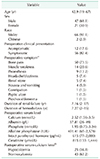1. Lennard T. Endocrine surgery: a companion to specialist surgical practice. Ann R Coll Surg Engl. 2010; 92:717.

2. Rashed A, Fahmi M, ElSayed M, Aboud O, Asim M. Effectiveness of surgical parathyroidectomy for secondary hyperparathyroidism in renal dialysis patients in Qatar. Transplant Proc. 2004; 36:1815–1817.


3. Gourgiotis S, Moustafellos P, Stratopoulos C, Vougas V, Drakopoulos S, Hadjiyannakis E. Total parathyroidectomy with autotransplantation in patients with renal hyperparathyroidism: indications and surgical approach. Hormones (Athens). 2006; 5:270–275.


4. Saliba W, El-Haddad B. Secondary hyperparathyroidism: pathophysiology and treatment. J Am Board Fam Med. 2009; 22:574–581.


5. Tominaga Y. Surgical treatment of secondary hyperparathyroidism due to chronic kidney disease. Ups J Med Sci. 2006; 111:277–292.

6. Hamouda M, Dhia NB, Aloui S, El Mhamedi S, Skhiri H, Elmay M. Predictors of early post-operative hypocalcemia after parathyroidectomy for secondary hyperparathyroidism. Saudi J Kidney Dis Transpl. 2013; 24:1165–1169.


7. Mittendorf EA, Merlino JI, McHenry CR. Post-parathyroidectomy hypocalcemia: incidence, risk factors, and management. Am Surg. 2004; 70:114–119.

8. Stewart ZA, Blackford A, Somervell H, Friedman K, Garrett-Mayer E, Dackiw AP, et al. 25-hydroxyvitamin D deficiency is a risk factor for symptoms of postoperative hypocalcemia and secondary hyperparathyroidism after minimally invasive parathyroidectomy. Surgery. 2005; 138:1018–1025.


9. Torer N, Torun D, Torer N, Micozkadioglu H, Noyan T, Ozdemir FN, et al. Predictors of early postoperative hypocalcemia in hemodialysis patients with secondary hyperparathyroidism. Transplant Proc. 2009; 41:3642–3646.


10. Hosmer DW, Lemeshow S, Sturdivant RX. Applied logistic regression. 3rd ed. Hoboken: John Wiley & Sons;2013.
12. Kaya C, Tam AA, Dirikoc A, Kilicyazgan A, Kilic M, Turkolmez S, et al. Hypocalcemia development in patients operated for primary hyperparathyroidism: can it be predicted preoperatively? Arch Endocrinol Metab. 2016; 60:465–471.


14. Zamboni WA, Folse R. Adenoma weight: a predictor of transient hypocalcemia after parathyroidectomy. Am J Surg. 1986; 152:611–615.


15. Akerstrom G, Malmaeus J, Bergstrom R. Surgical anatomy of human parathyroid glands. Surgery. 1984; 95:14–21.

16. Tsai WC, Peng YS, Chiu YL, Wu HY, Pai MF, Hsu SP, et al. Risk factors for severe hypocalcemia after parathyroidectomy in prevalent dialysis patients with secondary hyperparathyroidism. Int Urol Nephrol. 2015; 47:1203–1207.


17. Puccini M, Carpi A, Cupisti A, Caprioli R, Iacconi P, Barsotti M, et al. Total parathyroidectomy without autotransplantation for the treatment of secondary hyperparathyroidism associated with chronic kidney disease: clinical and laboratory long-term follow-up. Biomed Pharmacother. 2010; 64:359–362.


18. Stracke S, Keller F, Steinbach G, Henne-Bruns D, Wuerl P. Long-term outcome after total parathyroidectomy for the management of secondary hyperparathyroidism. Nephron Clin Pract. 2009; 111:c102–c109.

19. Farese S. The hungry bone syndrome--an update. Ther Umsch. 2007; 64:277–280.

20. Loke SC, Kanesvaran R, Yahya R, Fisal L, Wong TW, Loong YY. Efficacy of an intravenous calcium gluconate infusion in controlling serum calcium after parathyroidectomy for secondary hyperparathyroidism. Ann Acad Med Singapore. 2009; 38:1074–1080.

21. Brasier AR, Nussbaum SR. Hungry bone syndrome: clinical and biochemical predictors of its occurrence after parathyroid surgery. Am J Med. 1988; 84:654–660.


22. Erbil Y, Bozbora A, Ozbey N, Issever H, Aral F, Ozarmagan S, et al. Predictive value of age and serum parathormone and vitamin d3 levels for postoperative hypocalcemia after total thyroidectomy for nontoxic multinodular goiter. Arch Surg. 2007; 142:1182–1187.


23. Ellul D, Townsley RB, Clark LJ. Does the pre-operative serum phosphate level predict early hypocalcaemia following parathyroidectomy for primary hyperparathyroidism? Surgeon. 2013; 11:125–129.


24. Vasher M, Goodman A, Politz D, Norman J. Postoperative calcium requirements in 6,000 patients undergoing outpatient parathyroidectomy: easily avoiding symptomatic hypocalcemia. J Am Coll Surg. 2010; 211:49–54.


25. Randhawa PS, Mace AD, Nouraei SA, Stearns MP. Primary hyperparathyroidism: do perioperative biochemical variables correlate with parathyroid adenoma weight or volume? Clin Otolaryngol. 2007; 32:179–184.







 PDF
PDF ePub
ePub Citation
Citation Print
Print




 XML Download
XML Download